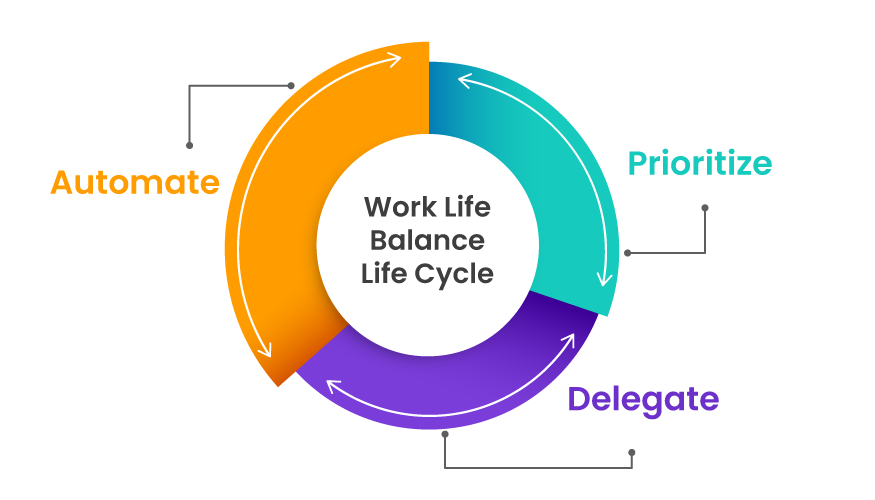
This article was first published on Customer Think.
When was the last time you stopped work at 5 PM sharp, went for a walk, had dinner on time, sat with a book in your hand, and got 7-8 hours of sleep?
Exactly.
With traditional hours out of the window and endless Zoom calls, sitting through the day, the question arises: are we alive to work or working to be alive? Not that the ‘always online, always available’ culture didn’t exist before, it was never talked about.
In fact, it was frowned upon, but with changing trends in WFH, Gen Z entering the workforce, and the pandemic hitting us, we’re talking about the need of not a line between work and personal life but fitting in both like pieces of a jigsaw puzzle and the bigger picture looking perfect.
We know it, we’ve read how long work hours are actually not healthy and the benefits of having a balance. But, even though the idea of wanting to ‘chill’ and relax after 5 or 6 PM is ideal and sounds appealing, being able to put it into action is a different ball game.
It’s like when one thinks on a Friday that they’ll start working out on the coming Monday, but the blues take over. Unless they take action, there are no miracles happening there.
The problem isn’t that they don’t want to take action, the problem lies in the work and how it’s done.
One doesn’t even realize how some of the reasons affect their ability to achieve work-life balance. And as you read, you’ll definitely come across some that slow down work, extend it, or carry it forward to weekends too!
Also read: Post-Pandemic Productivity 101: A Hybrid Model of Work From Home & Office!
What tips the scales of our Work-Life-Balance?
1. Meetings that could have been emails or even better
How many hours of your day are spent in calls or meetings that could easily have been either emails or 5-minute updates over a simple automated workflow?
These calls extend through the day, leaving actual work behind. If you’ve been one of the people who were stuck on calls till 2 PM and the actual work got extended till 7 or 8 PM?
2. Too many cooks, too many hiccups
Sometimes, teamwork isn’t the dreamwork- yes. Why? Because accountability decreases as more and more people get added to a supposed 2 people task.
This essay titled “Parkinson’s Law,” published in The Economist in 1955 by a British naval historian Cyril Northcote Parkinson, elaborates that even though the British Admiralty between 1914 and 1928 increased, the work produced or productivity remained the same! Why?
Because people kept playing passing-the-parcel (of work) which resulted in delays and stress for the manager.
This happens when more than necessary people get involved resulting in decreased accountability and extension of work hours for everyone because of the above paradox.
3. Hamster on the wheel
Well, that’s a no-brainer. Literally.
People spend hours doing one process day in and day out manually and spending hours on a task which, with a systematic workflow, can easily be automated.
Simple tasks such as forms and Excel sheet reports that are repetitive in nature will take up time, and you do them day in and out without even realizing how you may lose up to 22% of your time, which is almost 2 out of 8 hours of your day! Manual workflows cost the enterprise, not just financially but majorly productively!
So, how do we not be hamsters, and how do we tip our work-life balance scales that fit like a glove and actually give us the satisfaction of working without having to slog?
It’s actually 3 steps – P D A!
The PDA through Life Model

1. Prioritize
The first and foremost is prioritizing your task list. Looking at immediate deadlines instead of sitting on an hour-long call for a project that may happen next year instead of looking at a call that needs to be taken by that evening.
That doesn’t mean you have to wait until the last minute to plan next year’s project! No, it simply means mindfully taking out time once the urgent, important tasks are completed. Does this project need planning? Get the relevant people involved only.
Instead of asking yourself what all you need to get done today, ask yourself what cannot wait until tomorrow.
2. Delegate
After asking yourself what cannot wait until tomorrow, ask yourself what cannot be done by my team members. Once you have a clear idea of what can be carried out by the team and can be delegated, you’ll realize out of 10 tasks, you (and your team) actually have to accomplish 8 tasks, and you, and solely you, have to focus on 3-4 tasks in the day only.
Once you figure out what needs to be done by you and what can be delegated, you can have the task list completion or approvals automated too. You don’t have to ask for constant updates or progress reports once a process is set in place.
Proper, efficient delegation of tasks (and not getting too many cooks involved) works best since 1. It creates accountability, 2. Increases your productivity 3. Helps you achieve the balance since instead of doing 8 tasks, you’ll do 4 now! That is the power of delegating tasks, and no-code tools like Quixy, Calendly, and Asana can help you achieve that!
Also Read: Literally the Best Google Chrome Extensions for Productivity
3. Automate
One of the key drivers of the whole ‘work-life balance’ argument is spending time doing things that matter to the organization that requires your human intellect and retaining that. You’ll be able to switch off at 5 or 6 PM if you know and have achieved what your contribution to the work is that isn’t your administrative tasks like sending emails or creating reports.
Problem-solving and decision-making for business strategy is something that is not necessarily automatable, but getting updates and progress reports is. To achieve that level of balance, automation is key today. If you find that a major chunk of your day is going into approvals and updates, the actual work takes a back seat for you extending your hours.
The base pillar of going about achieving work-life balance is automating processes that take up time and energy on a frequent basis. It is called Digital Process Automation (DPA) and it will radically change your way of working, making it easier for you to take out time for yourself. It’s not a promise, it’s a guarantee.

Conclusion
Work-life balance is not magic. It’s a
Increasing cognitive and emotional awareness that gives you the understanding of what needs to be prioritized, delegated, and automated will put things into perspective and help achieve the business and personal goals one is aiming for.
There are numerous tools that can help enhance this cycle. One of them is Quixy, a no-code application platform where the possibilities to automate and manage processes are endless! It helps tackle the fall-backs of manual processes and achieve business goals with no-code.
With such support, not only will it make your work life a breeze, but it will also create a balance in the personal space and help give time for and to yourself and your loved ones.
Login
Please login to comment
0 Comments
Oldest















